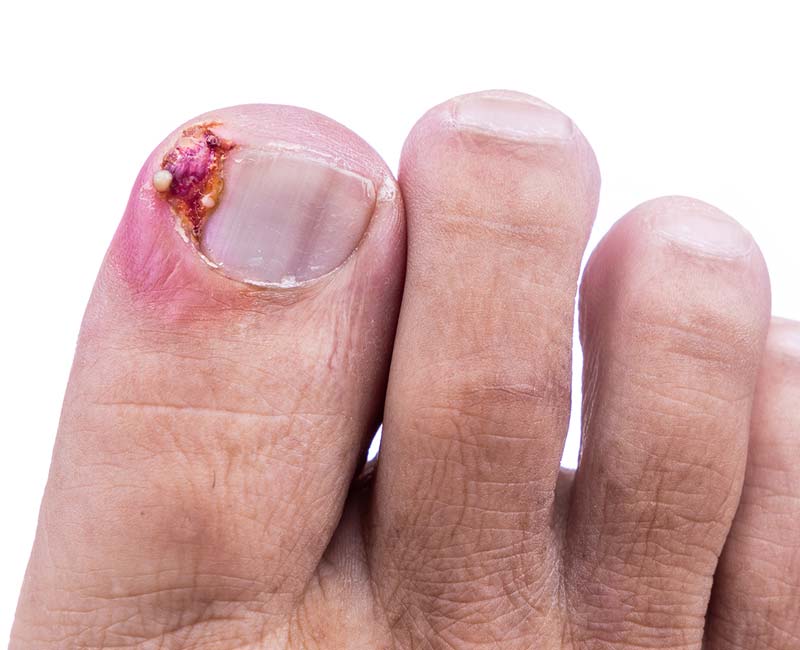Overview Of Ingrown toenails
Ingrown toenails occur when the edge or corner of a toenail grows into the surrounding skin, causing pain, redness, swelling, and sometimes infection. This condition most commonly affects the big toe and can result from improper nail trimming, tight footwear, or trauma to the toe. Ingrown toenails can range from mild discomfort to severe pain and may require medical intervention if an infection develops. Proper nail care, footwear choices, and early treatment are essential to prevent complications and ensure relief. ---
Symptoms of Ingrown toenails
- The symptoms of ingrown toenails include pain, tenderness, and swelling at the affected nail edge. The surrounding skin may appear red and inflamed, and in some cases, there may be drainage of pus or fluid, indicating an infection. The toe may feel warm to the touch, and walking or wearing shoes can exacerbate the discomfort. In severe cases, the skin around the nail may overgrow, forming granulation tissue. Early recognition of symptoms helps in prompt treatment and prevents complications. ---
Causes of Ingrown toenails
- Ingrown toenails are primarily caused by improper nail trimming, such as cutting nails too short or rounding the edges, which encourages the nail to grow into the skin. Wearing tight or ill-fitting shoes that compress the toes can also contribute to the condition. Trauma to the toe, such as stubbing or repetitive pressure from activities like running, may lead to ingrown nails. Genetic predisposition, such as naturally curved nails, increases the risk. Poor foot hygiene or excessive sweating can exacerbate the problem. Understanding these causes helps in prevention and management. ---
Risk Factors of Ingrown toenails
- Several factors increase the risk of developing ingrown toenails. Improper nail trimming techniques, such as cutting nails too short or rounding the edges, are significant risk factors. Wearing tight or narrow shoes that compress the toes elevates the risk. Activities that involve repetitive pressure on the toes, such as running or soccer, can also contribute. Genetic predisposition, such as naturally curved or thick nails, increases susceptibility. Poor foot hygiene, excessive sweating, or underlying conditions like diabetes further elevate the risk. Preventive measures, such as proper nail care and footwear choices, reduce the likelihood of ingrown toenails. ---
Prevention of Ingrown toenails
- Preventing ingrown toenails involves adopting proper nail care and footwear practices. Trim nails straight across and avoid cutting them too short or rounding the edges. Wear well-fitting shoes with adequate toe room to reduce pressure on the nails. Maintain good foot hygiene by keeping feet clean and dry. Avoid repetitive trauma to the toes, such as kicking or stubbing. For individuals with naturally curved nails or recurrent ingrown nails, regular podiatric care may be necessary. Educating individuals about preventive measures ensures long-term relief. ---
Prognosis of Ingrown toenails
- The prognosis for ingrown toenails is generally good with proper care. Most mild cases resolve with home treatment and preventive measures. Severe or recurrent cases may require medical intervention but typically heal without long-term complications. Early diagnosis and treatment prevent complications, such as chronic infection or nail deformities. Educating individuals about proper nail care and footwear choices ensures long-term relief and reduces the risk of recurrence. ---
Complications of Ingrown toenails
- Untreated or poorly managed ingrown toenails can lead to several complications. Persistent inflammation or infection can cause abscess formation or cellulitis, a bacterial skin infection. In severe cases, the infection may spread to the bone (osteomyelitis) or bloodstream (sepsis). Chronic ingrown nails can lead to nail deformities or permanent changes in nail growth. Early intervention and proper wound care are essential to prevent complications and ensure a full recovery. ---
Related Diseases of Ingrown toenails
- Ingrown toenails are closely related to other foot conditions, such as fungal nail infections (onychomycosis) or paronychia (nail fold infection). They share similarities with other skin infections, such as cellulitis or abscesses, which can result from untreated ingrown nails. Chronic conditions, such as diabetes or peripheral vascular disease, increase the risk of complications from ingrown toenails. Understanding these related diseases is important for comprehensive diagnosis and management. Preventive measures for ingrown toenails also reduce the risk of other foot conditions. ---
Treatment of Ingrown toenails
The treatment of ingrown toenails depends on the severity of the condition. Mild cases can be managed at home by soaking the foot in warm water, gently lifting the nail edge, and applying antibiotic ointment. Wearing open-toed shoes and keeping the area clean and dry promotes healing. For more severe cases, a healthcare provider may need to remove the ingrown portion of the nail under local anesthesia. In recurrent or severe cases, partial or complete nail removal (avulsion) may be necessary. Antibiotics are prescribed if an infection is present. Early and targeted treatment improves outcomes. ---
Generics For Ingrown toenails
Our administration and support staff all have exceptional people skills and trained to assist you with all medical enquiries.




